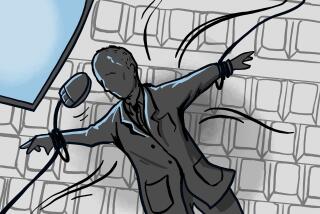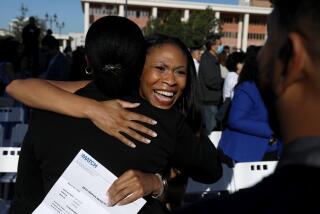Doctor’s Plot Parallels Headlines : ‘The Mask’ Tells Story of Army Medic Posing as Physician : 2 A federal report estimates that there are 10,000 fraudulent doctors practicing in the United States.
- Share via
The framed New York University Medical School diploma hanging on the wall bears the scripted name “Frank Raymond Di Fiore,” perhaps proof that Di Fiore is a legitimate surgeon; but why should we believe that the man sitting behind the desk is really Frank Di Fiore?
That’s a question he gets a lot these days, with last month’s release of his book, “The Mask” (Avon Books), the tale of a man who successfully impersonates a surgeon.
“Take that certificate on the wall,” Di Fiore said. “OK, so some guy named Frank Raymond Di Fiore is certified by the board of surgery. But is that this guy?” he says, gesturing to himself. “I don’t think it’s the most difficult thing in the world for somebody to become a phony doctor.”
Seated in his closet-sized Newport Beach office, Di Fiore (“a good Italian name--you have to sort of wiggle your fingers when you say it”) laughs about all the attention and good-natured kidding lavished on him by colleagues and patients in recent weeks.
However, he denies that “The Mask” is autobiographical.
“That’s one of the jokes running around the hospital. They want to know if it’s my autobiography. My standard answer is: ‘No, but I had one of my friends dictate it to me.’ ”
His first book with a major publishing house, “The Mask” details the exploits of an Army medic in Vietnam who assumes a doctor’s identity when their helicopter is shot down and the doctor is killed. With the doctor’s body burned beyond recognition, Richard Peters, a frustrated, would-be medical student, suddenly is thrust into the role of Dr. James Webber.
Discharged from the Army, Peters/Webber returns to the States and uses his rough, combat-honed medical skills to land a position at a clinic in the fictional town of Santa Madrinas north of San Francisco, where he settles into a life that is not really his.
The novel, with a first run of 50,000 copies, appeared on book stands with a remarkable timeliness. Barely a month earlier, California medical investigators arrested Enrique Herrera of Santa Ana and charged him with posing as a doctor for nearly 1 1/2 years at the Emergi-Care Family Center in Fountain Valley. In 1984, unlicensed Chicago pharmacist Gerald Barnes was arrested in Anaheim for trying to get a job as a physician just months after he pleaded guilty to involuntary manslaughter in connection with the death of a diabetic patient.
“So many things in this book have come true, it’s mind-boggling,” says Di Fiore, 56, a general surgeon and family man who, even after 25 years in California, retains some of his Bronx accent.
When the latest alleged medical impostor was arrested April 28, Di Fiore worried a little about the fate of his novel, then in his publisher’s hands.
“My immediate thought was, ‘Oh boy, somebody’s going to write a quickie book.’ Somebody’ll grind one out in 30 days . . . a quick, sloppo book about a phony doctor. And Avon’s sitting on my stuff back there. And then all of a sudden, bango, they were ready to go. It was more or less perfect timing.”
Di Fiore said he started writing “The Mask” in the summer of 1981.
“If Orange County has two (cases), how many are in the country?” he asked. “It would be harder today because orthopedics (his character’s specialty) has advanced a lot since the setting of that (book), which would be about 1970. . . . But you know, it depends on the background. Medical corpsmen get a lot of experience. . . . I think it could’ve been done at that time. Maybe even today, given the right individual.”
Federal statistics show that it is indeed done today, with startling regularity. A 1984 report by the House subcommittee on health and long-term care estimated that there are as many as 10,000 fraudulent doctors in the United States, representing one out of every 50 physicians.
Di Fiore’s book raises some interesting ethical dilemmas by throwing in an unexpected twist: His phony doctor turns out to be a superb surgeon. Should such a person be allowed to practice medicine without the requisite years of medical school, internship and residency?
It’s all relative, Di Fiore said. Is an incompetent certified doctor better than a talented one without a degree?
“Approximately 20% of the doctors in this country are foreign medical graduates,” he said. “Some of those guys went to very fine medical schools. A lot of them went to very peripheral places where you really don’t know what they got out of medical school--if anything.
“Now they don’t really have medical school training like I had. They don’t have that kind of exposure, that kind of intensity. All they have to be able to do is sit back in a lecture hall and remember what was said. Some of the interns I worked with in my training--those guys didn’t know anything about anything. And they were, quote, medical school graduates.”
The House subcommittee report, in fact, laid much of the medical fraud at the feet of foreign schools that provide inadequate training. Of the 14,000 foreign medical school graduates who came to the United States in the last two years, almost 85% failed to qualify for residency training. The subcommittee estimated that there are as many as 40,000 unlicensable foreign graduates in the United States, many of whom end up joining the “medical underground,” the report concluded.
Frank Di Fiore got his start writing about eight years ago, when, he said, he grew a little restless. Looking for something new to try, he enrolled in a UC Irvine writing course that required him to write a rough draft of a novel. A racehorse owner and breeder since 1969, Di Fiore drew on his major avocation and wrote several books he calls “horse capers.” However, he quickly discovered that such books rarely make it to the best-seller list--or to the publisher’s desk, for that matter.
Under a pseudonym, he wrote a book about handicapping horse races and set up his own publishing company to handle sales. But for his next work he decided to try something a little more marketable.
Plot There in 3 Minutes
“I had written another little novel about horses and was looking for something else to do,” he recalls. “I thought, ‘Gee, I ought to write some sort of doctor book.’ Too many of the doctor books fall into certain stereotype cliches--you know, the hero doctor working under adversity to save the patient. . . . Then I had the idea--how about a phony doctor? The plot was there in 15 minutes. It only took three more years to write the book. . . .”
He first finished the book, writing in the third person, in 1982, but a publisher rejected it, saying “it could never happen, it’s too farfetched.”
So Di Fiore went back to work, this time trying two new approaches: He changed the narrative voice to first person and bought a word processor. These two changes, he said, made a “tremendous” difference.
Di Fiore’s next project is another medical thriller, “a kind of murder mystery, adventure thing” that involves murder and hospital politics.
Hospital politics is a favorite target, and a subject he says he knows well from his days as chief of surgery, posts he held at Hoag Memorial Hospital Presbyterian in 1982-84 and last year at Costa Mesa Medical Center.
Meanwhile, he said, people he works with “keep looking in there to see if they recognize any of the characters,” he said. “In fact, one of my friends read it, and he said: ‘I know who that one guy is, the guy who could never make up his mind. I know who he is,’ and he mentioned the name. I said, ‘Not only are you wrong, but I never even thought about him!’ ”
But while the doctor is enjoying all the perks of authorship (he occasionally checks bookstores to see if they offer his novel and jots down the names of those that don’t), he still has a surgeon’s schedule to keep up with. On a recent day, he was called in for emergency surgery at 5 a.m., examined patients and met with visitors the rest of the normal working day, and then settled in at home for a little writing.
More to Read
Sign up for our Book Club newsletter
Get the latest news, events and more from the Los Angeles Times Book Club, and help us get L.A. reading and talking.
You may occasionally receive promotional content from the Los Angeles Times.







